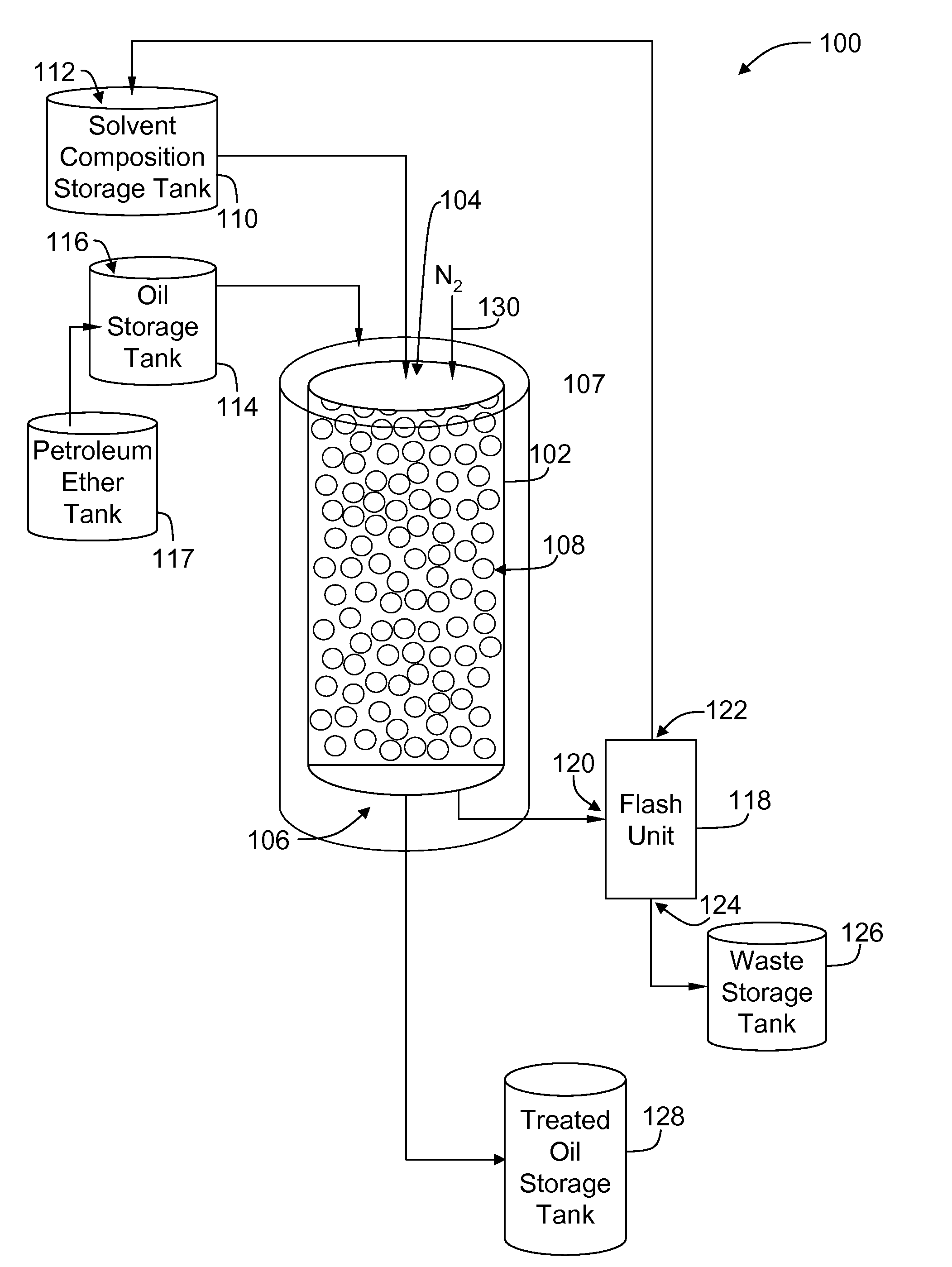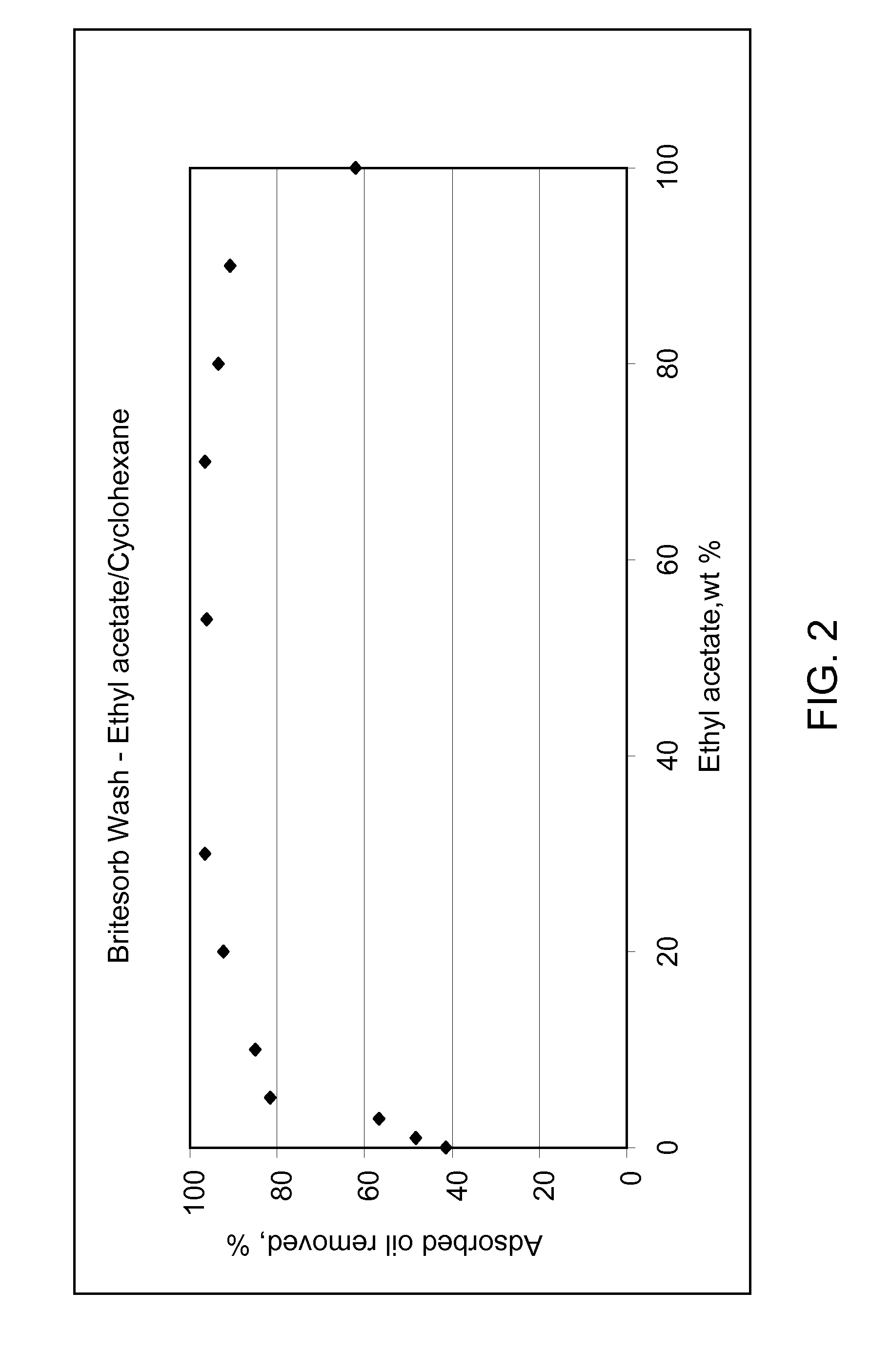Methods and system for regeneration of adsorbent material
a technology of adsorbent material and adsorption chamber, which is applied in the direction of liquid displacement, separation process, and other chemical processes, can solve the problems of limiting the direct use of crude oil or heavy oil as fuel, increasing the operational and maintenance costs of industrial facilities, and reducing the overall efficiency of the system, so as to facilitate the removal of oil and impurities
- Summary
- Abstract
- Description
- Claims
- Application Information
AI Technical Summary
Benefits of technology
Problems solved by technology
Method used
Image
Examples
example 1
Regeneration of Spent Adsorbents Using Polar / Non-Polar Wash Solutions
[0028]In the first example, spent adsorbent was prepared. More specifically, in this example, approximately 35 grams of Britesorb® D350EL silica adsorbent was weighed into a blender, and approximately 100 g of Saudi heavy crude oil and 200 g of petroleum ether were then added to the blender. The resulting slurry was mixed for about five minutes at room temperature and was then poured into centrifuge tubes. Each tube was centrifuged, and the resulting liquid fractions were decanted, thus leaving soiled, or spent, Britesorb® D350EL solids. The soiled Britesorb® D350EL solids were dried under vacuum at 80° C. for about two hours. The dried solids were then analyzed using a Thermogravimetric Analyzer (TGA). The percent weight loss between the initial onset of devolatization and / or decomposition at about 200° C. to about 650° C. was taken as the removal of the residual organic material (oil components) from the adsorben...
example 2
Regeneration of Britesorb D350 EL® Using Ethyl Acetate and Cyclohexane
[0033]Initially, about 3.5 g of Britesorb D350 EL® xerogel silica was weighed into a blender and about 10 g of crude oil and 40 g of petroleum ether was added to the blender. The resulting slurry was mixed for 2 minutes and was then poured into centrifuge tubes. Each tube was then centrifuged and the liquid fraction was decanted into vials, and the vanadium and nickel contents of the liquid fraction were measured by Inductively Coupled Plasma Emission Spectrometry / Mass Spectrometry (ICP / MS).
[0034]The solid fraction, or spent adsorbent, was then extracted with cyclohexane and ethyl acetate. The resulting solids were analyzed and the results illustrate that neither the cyclohexane nor the ethyl acetate alone removed all of the adsorbed oil. Next, the solid fraction was extracted with a binary solution consisting of 3 wt. % ethyl acetate and 97 wt. % cyclohexane. The resulting solids were analyzed and the results ill...
example 3
Re-Use of Extracted Britesorb D350 EL®
[0035]Initially, about 2.53 g of spent Britesorb® D350EL that was extracted with ethyl acetate / cyclohexane was weighed into a blender, and about 7.25 g of crude oil and 29 g of petroleum ether was added to the blender. The resulting slurry was mixed and poured into centrifuge tubes. Each tube was centrifuged and the liquid fraction was decanted into vials. The vanadium and nickel contents were then measured by ICP / MS. The nickel and vanadium concentration of the oil-petroleum ether solution was below 0.1 ppm.
PUM
| Property | Measurement | Unit |
|---|---|---|
| weight % | aaaaa | aaaaa |
| weight % | aaaaa | aaaaa |
| weight % | aaaaa | aaaaa |
Abstract
Description
Claims
Application Information
 Login to View More
Login to View More - R&D
- Intellectual Property
- Life Sciences
- Materials
- Tech Scout
- Unparalleled Data Quality
- Higher Quality Content
- 60% Fewer Hallucinations
Browse by: Latest US Patents, China's latest patents, Technical Efficacy Thesaurus, Application Domain, Technology Topic, Popular Technical Reports.
© 2025 PatSnap. All rights reserved.Legal|Privacy policy|Modern Slavery Act Transparency Statement|Sitemap|About US| Contact US: help@patsnap.com



